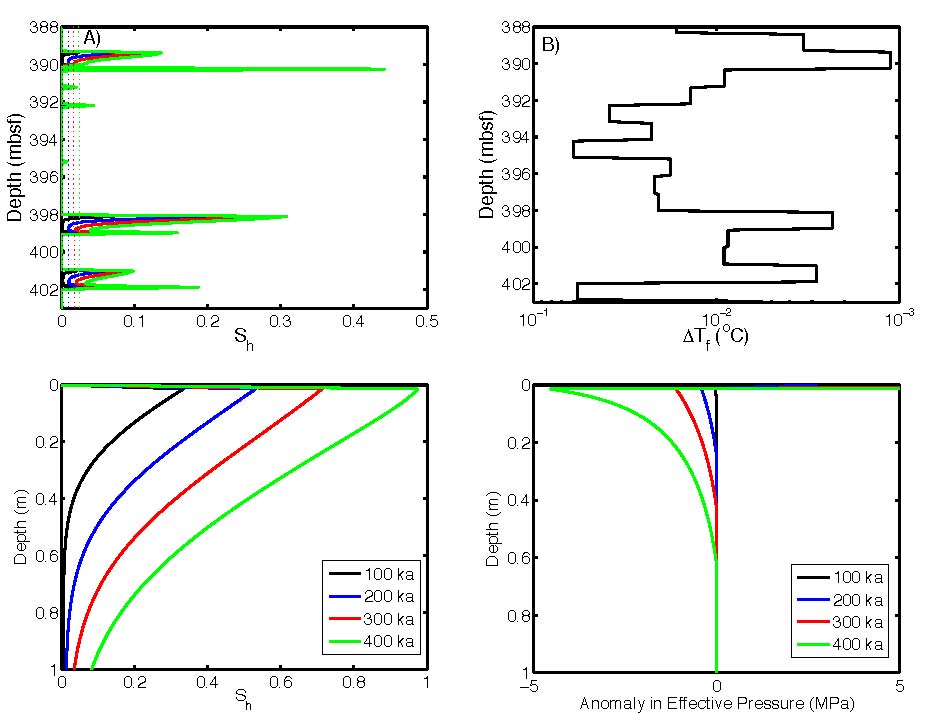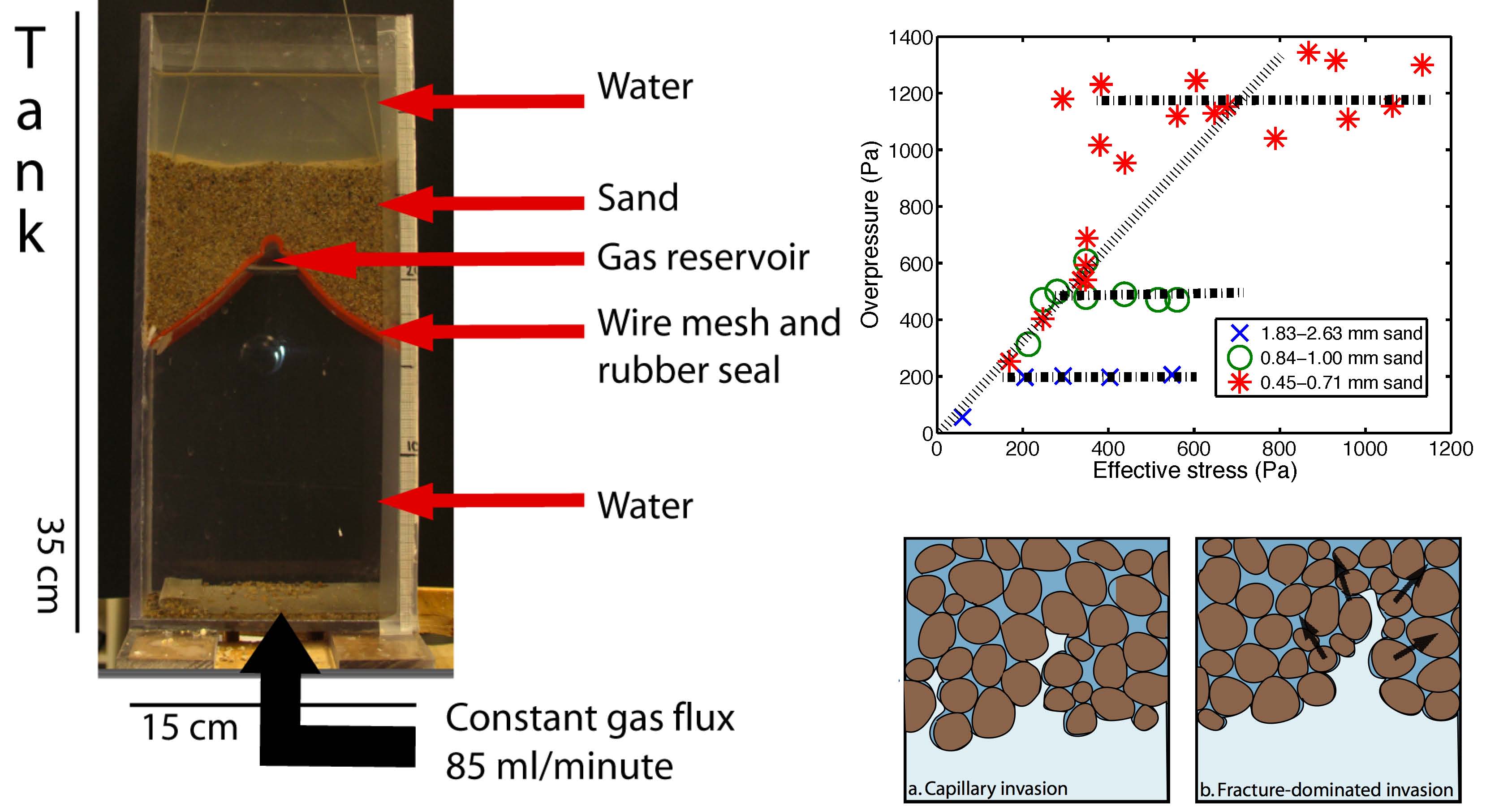AmericanChemicalSociety.com
Reports: G8 47851-G8: Hydrate Distribution, Dissociation, and Growth in Sediments
Alan W. Rempel, University of Oregon
September 29, 2010
At the close of the 2nd year of this award, we are proud to report having essentially completed the work described in the proposal. In meeting our primary goal of describing the influence of sediment properties on hydrate reservoir development, we have uncovered related areas of research interest that are also of critical importance. Former lab member and recent graduate, Kristen Fauria, took the lead in conducting analogue experiments that informed our physical description of gas transport through fine-grained sediments. This work formed the basis of Kristen’s senior thesis, which is being repackaged and will soon be submitted for publication in Earth and Planetary Science Letters. A second publication that describes our new understanding of how variations in sediment properties are reflected in the hydrate distribution found in natural reservoirs will soon be submitted to the Journal of Geophysical Research. Significant recent developments have taken place since the PI gave an invited seminar on this work at the inaugural Gordon Research Conference on Natural Gas Hydrate Systems this past June. Kristen Fauria presented the gas transport work in a poster at the same conference. Significant contributions to this project were also made by graduate students Sara Papamarcos, Rob Skarbek, and Laura van Alst. Figure 1 summarizes some of the central results from our study of the role of sediment properties on hydrate distribution. The gas concentration required for two-phase equilibrium between hydrate and an aqueous solution of the guest component (here methane) is affected by surface energy and wetting effects that both cause perturbations that become increasingly important for more fine-grained sediments. The extent to which the equilibrium concentration is affected is gauged here by the undercooling ΔTf by which the local dissociation temperature is altered – shown on a reverse logarithmic scale in the upper right. At stratigraphic boundaries the gas concentration must remain continuous and this has the effect of prohibiting hydrate formation in more fine-grained (higher ΔTf ) sediments; the average rate of hydrate accumulation given by the dashed profiles in the upper left is unchanged from that which would be predicted in homogeneous sediments since the missing hydrate accumulates in the prominent spikes on the boundaries of the coarse-grained fraction. The panels below show the hydrate saturation profiles of such an idealized spike in more detail. At high saturation levels (here for Sh > 30%) hydrate forms an interconnected network and the wetting interactions that maintain thin unfrozen films between the sediment and hydrate surfaces transmit forces that partially unload sediment contacts, as shown on the right. This leads ultimately to the segregated growth forms that are sometimes seen in nature.
Figure 1: Top: A) Close-up of predicted hydrate saturation profiles in a heterogeneous deposit and B) undercooling profile used to gauge the influence of sediment properties. The color scheme is the same as below, with different lines representing different model ages since accumulation began. Dashed curves show the long-range average accumulation. Note that the logarithmic ΔTf axis is reversed in B). Bottom: left) evolution of an idealized spike; right) deviation of effective stress from background levels.
Figure 2 summarizes our work on determining the controls that govern how gas passes through fine-grained sediments. Gas was injected into a water reservoir, and collected below a wire mesh that supported a sand column. The thickness of the gas reservoir is tied directly to the difference in pressure between the gas and the liquid that initially saturates the loose sand above. In the upper right, this overpressure is plotted as a function of the effective stress between sediment contacts (determined by the thickness of the sand column) at the first moment of gas invasion into the sediments (captured on a high speed camera). When capillary forces are primarily responsible for resisting gas invasion, the overpressure depends only on the particle grain size – as reflected by the horizontal dot-dashed trends in the experimental data. At low sand column thicknesses, the effective stress at particle contacts is easily overcome by the pressure of the gas below and this causes fractures to propagate upwards, displacing the sand particles so that fracture-dominated invasion takes place – as reflected by the trend of the angled dotted line on the experimental plot. These distinct mechanisms of gas invasion are depicted schematically in the lower right.
Figure 2: Clockwise from left: apparatus for examining gas transport through sediments; experimental results for initial passage of gas through the sediment column; schematic showing two distinct modes of gas transport that are either limited by capillary invasion (as for the results along the horizontal dot-dashed trends in the experimental results) or dominated by fracture propagation (as for the results along the sloped dotted line above).
The PRF starter grant has supported work that has enabled our group to build upon the insight gained in previous, related studies and make substantial contributions to this field of research. Our initial success has been recognized by the invitation, mentioned earlier, to speak at a Gordon Research Conference this past summer. Kristen Fauria used resources made available on this grant to conduct her experimental study and write her undergraduate thesis. While at the conference, her first ever of this kind, Kristen received numerous offers of graduate positions that she will be choosing between for the next academic year. The PRF fund supported some of the work performed by graduate student Rob Skarbek, who has been investigating pore compaction in subduction zone environments where hydrates give some of our best constraints on the local heat flow regime. Initial laboratory efforts by graduate student Laura van Alst were also supported by this grant, though ultimately she chose to engage in a separate research topic that relates to freezing of ice in pore sediments. Graduate student, Sara Papamarcos, has begun working on theoretical treatments of solidification dynamics that have been motivated in part by the discoveries made under this grant.Copyright © American Chemical Society

